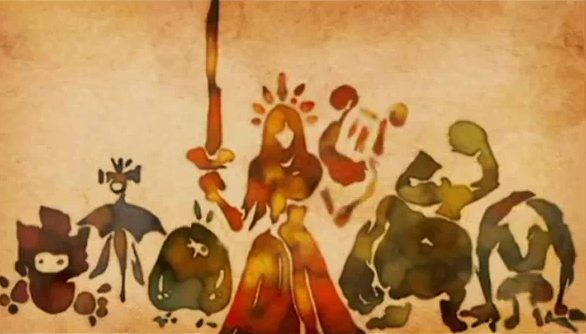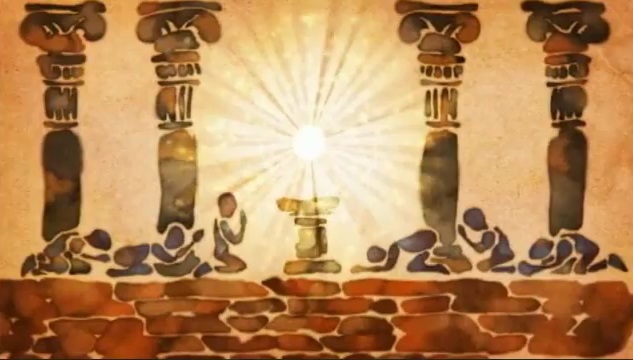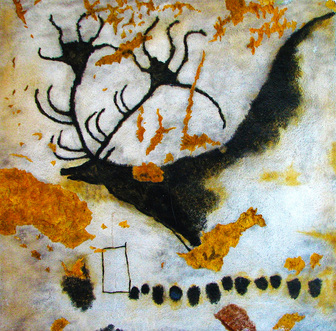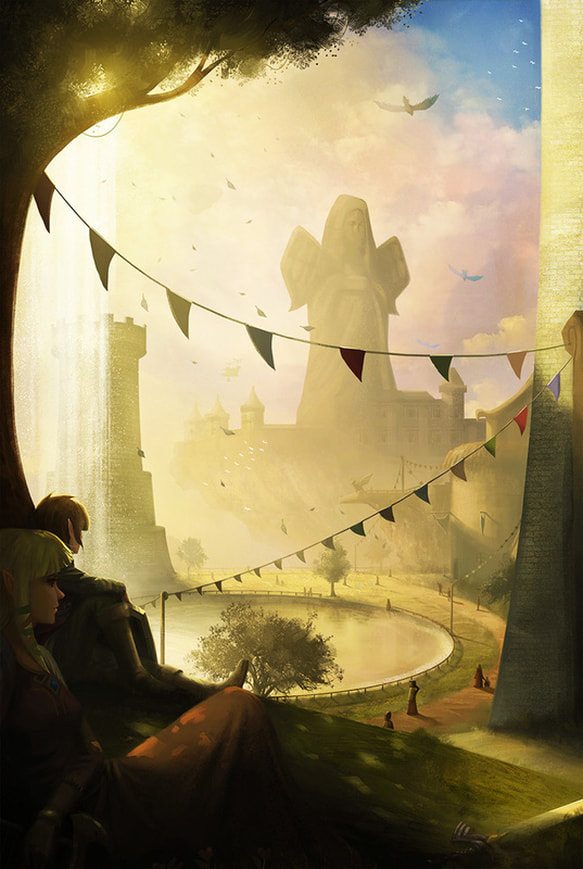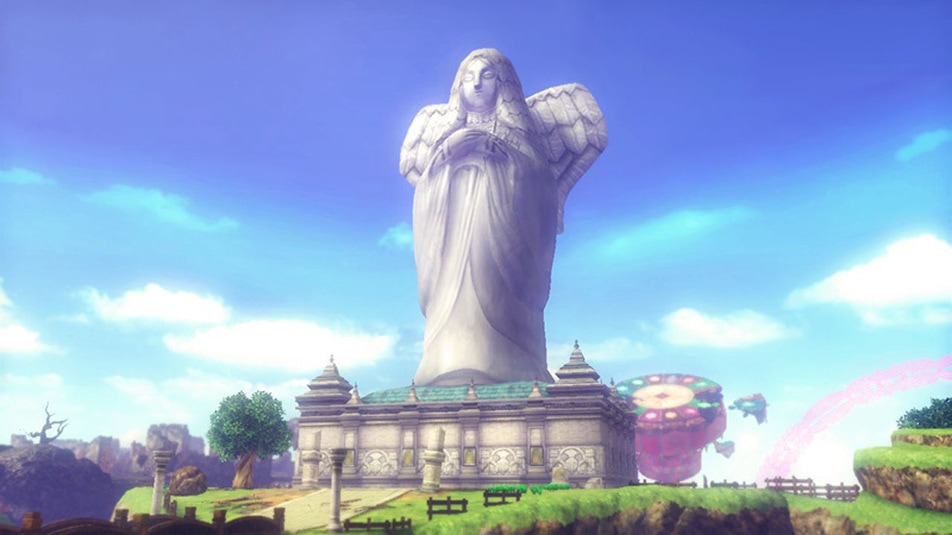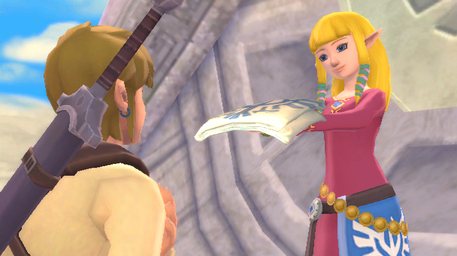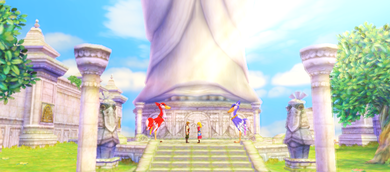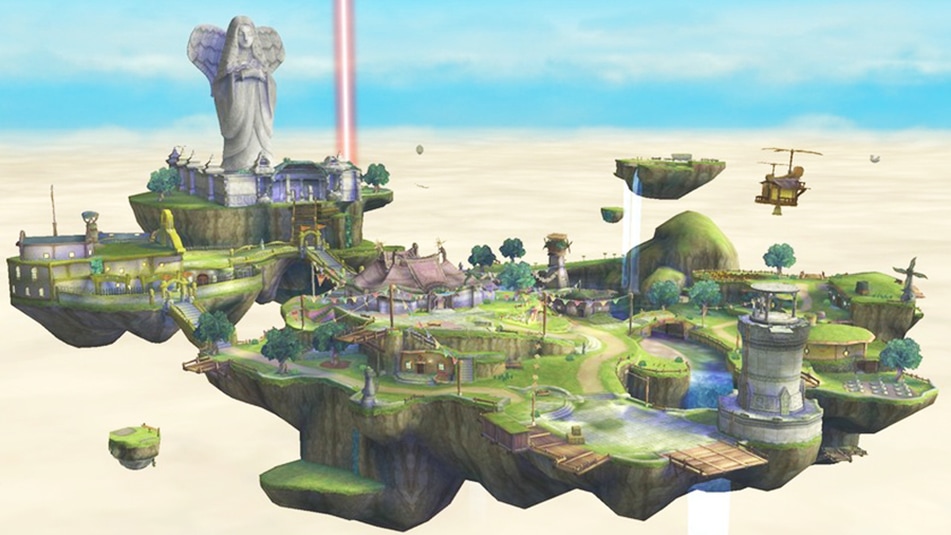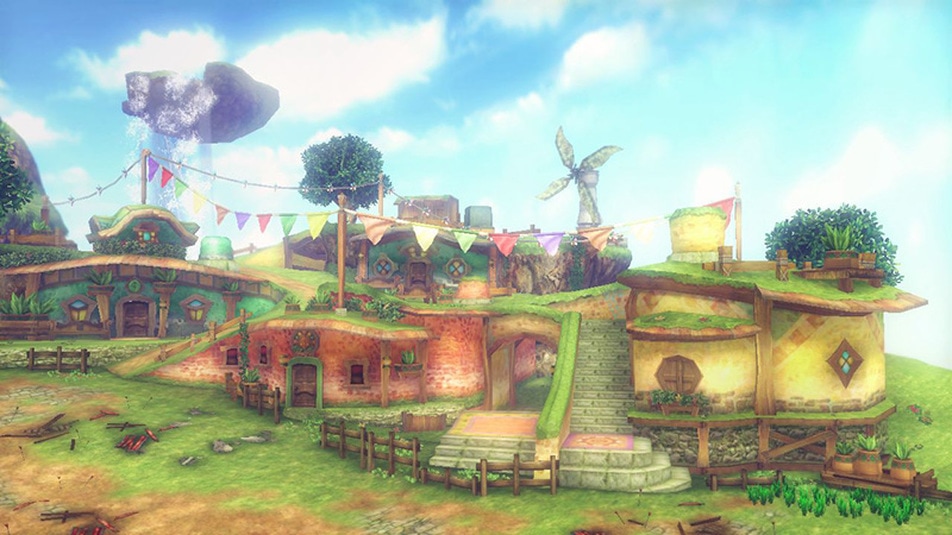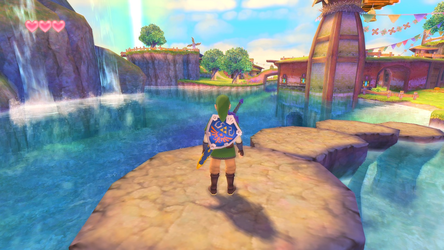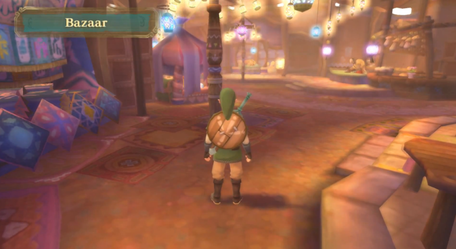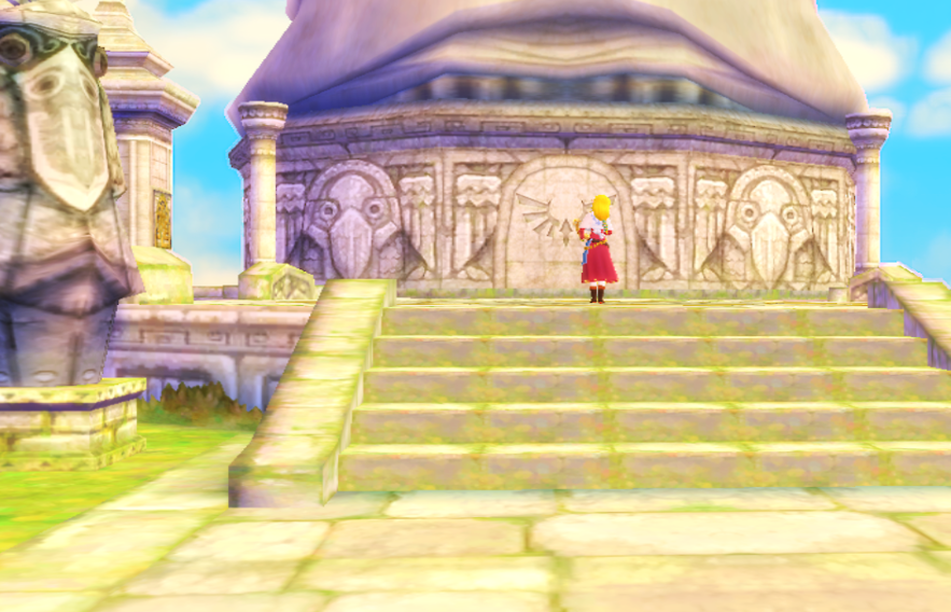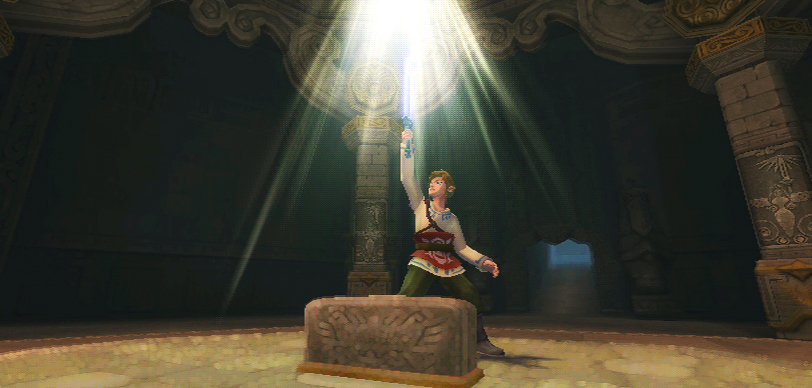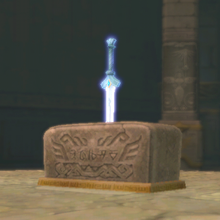Skyloft and the Provenance of Legend
“This is a tale that you humans have passed down through uncounted generations . . .”
Skyward Sword speaks of age, of history, and of legend more so than any other title within the Zelda franchise. As the first game of the series’ chronology, it seeks to provide the foundation for all following worlds, cultures, and characters. It establishes fundamental histories, enriches the universe through myth and lore, and introduces the most common and most critical thematic elements of this cyclical tale. The tapestry it weaves speaks of ancient and forgotten superstition, the creation of the lasting idea of the Hero, the Maiden, and the Great Evil, and traces the cultural dissemination of these concepts from humans in the earliest known epochs. Stories, as we all know, hold great and abiding power, but few have shaped the course of civilization so profoundly as has the traditional epic of Hyrule in a land before there was a Hyrule.
Skyward Sword speaks of age, of history, and of legend more so than any other title within the Zelda franchise. As the first game of the series’ chronology, it seeks to provide the foundation for all following worlds, cultures, and characters. It establishes fundamental histories, enriches the universe through myth and lore, and introduces the most common and most critical thematic elements of this cyclical tale. The tapestry it weaves speaks of ancient and forgotten superstition, the creation of the lasting idea of the Hero, the Maiden, and the Great Evil, and traces the cultural dissemination of these concepts from humans in the earliest known epochs. Stories, as we all know, hold great and abiding power, but few have shaped the course of civilization so profoundly as has the traditional epic of Hyrule in a land before there was a Hyrule.
In one of the most humbling of introductions to any Zelda title, an immediate connection is drawn between the humans who dwell in the land of the Goddesses, and we who dwell upon Earth. Though never overly explicit, the prelude is done in an artistic style found among some of the earliest human populations. Cave systems at Altamira in Spain, and within French caves at Lascaux and Chauvet, speak of nature and man, and the relationship between the two in beautifully-depicted, and deeply mysterious, charcoal and red ocher paintings. In firelight, the images are brought to life by the dancing of the flames, and great and gentle shadows are cast over the forms, causing them to vanish and then reappear, as if they are given to movement in the presence of heat and light. They seem dormant, but in an atmosphere similar to that of their creation, their latent energy emerges from the cold stone. The paintings have an obvious air of antiquity, being many, many thousands of years old, and far beyond even the earliest historical accounts. They are heavily abstracted, and the combination of strange geometric designs, animalistic creatures (some of which are still unknown, and some of which are chimeric), and the placement of the paintings all culminate in what some perceive to be a narrative — an early documentation of mankind’s interaction with the world. Many others believe these enigmatic caves to hold particular religious significance, and some maintain that the pictures upon the cave ceilings are actually primitive star charts. Paleolithic art, in general, was far less complex than art today, and the predominant items of artistic focus were animals, hunting scenes, and women — key figures within an ever-forming territory of Fertility Goddess worship across Europe.
The two actual cave paintings above are from Lascaux, in France. I hope that the artistic similarities between these art forms is evident.
With this prehistoric art style in mind, the introduction begins, speaking of a long war of prodigious ferocity. Dark forces poured forth from the earth, attacking those who dwelled upon the surface. The forests burned, fertile plains became parched land, and the people were massacred. These infernal beasts, under the banner of a sovereign and powerful Demon Lord, sought the power protected by the goddess. Fearing for the safety of her chosen creatures, the goddess Hylia gathered a part of humanity upon land, and, severing it from earth, sent it above even the clouds. While the humans made sense of their new home in the ether, the opposing forces below clashed and suffered. Thanks to the sacrifice of Hylia, the war came to an end, and a tenuous peace was resuscitated after the sealing of the Demon Lord and the defeat of his horde. This tale has been passed down for innumerable generations, and interwoven with it are many other legends, among which is this legend, the one that began them all.
There is one unanswered question that has remained with me throughout the years. Indeed, it is likely unanswerable. Why were humans, of all races, chosen? This privileged species, at the cost of all those others who fought and died below the cloud-wall, was gathered and protected, and allowed to live an Arcadian life in the skies. Within the realm of Zelda, it is folly to doubt the verity of the existing religious traditions, so it appears logical that humans were chosen to fulfill some special purpose, or because they were most gifted among the children of the Goddesses. From a rather brazen secular perspective, these legends seem the creation of a purpose-seeking humanity which built its perceived holiness on a foundation of assumptions. Regardless, it is an interesting philosophical question, whether or not it has an absolute truth about it.
There is one unanswered question that has remained with me throughout the years. Indeed, it is likely unanswerable. Why were humans, of all races, chosen? This privileged species, at the cost of all those others who fought and died below the cloud-wall, was gathered and protected, and allowed to live an Arcadian life in the skies. Within the realm of Zelda, it is folly to doubt the verity of the existing religious traditions, so it appears logical that humans were chosen to fulfill some special purpose, or because they were most gifted among the children of the Goddesses. From a rather brazen secular perspective, these legends seem the creation of a purpose-seeking humanity which built its perceived holiness on a foundation of assumptions. Regardless, it is an interesting philosophical question, whether or not it has an absolute truth about it.
Artistic credit to: http://yagaminoue.deviantart.com/
Within Skyloft, and especially among its residents, knowledge of the surface has all but disappeared, only mentioned in historical texts and, even more rarely, in ancient oral traditions. Yet, as within all civilizations, traces and remnants of these archaic myths live on in ritual and ceremony. And Skyloft has an elaborate and revered system of holy days and observances, most notably the annual Wing Ceremony, wherein new knights are chosen to protect the townsfolk, and certain participants reenact the meeting of the Goddess Hylia and her chosen Hero. Loftwings are believed to be a symbol of divine protection, and Skyloftians hold that they are only made complete by their guardian birds. These creatures of flight hold critical significance within many aspects of life above the clouds — from their presence in architecture, in trade, and in religion. This is a distinctive rite of passage, and one of the rare instances within this game series that we are privy to Hylian religious traditions. The goddess incarnate and her Hero tryst atop the Statue of the Goddess upon a platform formed by its outstretched hands. Then, the Bird Statuette obtained during the Contest of Flight is offered to the effigy of Hylia. After the statuette has been offered to the goddess, taking up her sacred harp, the actress then intones a prayer:
“Great goddess, guiding light and protector of our people, grant us your blessing and mercy as I act in your stead during this ceremony. Valiant youth who grasped victory at the celebration of the bird folk, and in accordance with the old ways, I now bestow the blessings of the goddess upon you. The blessings of the goddess drift down from the heavens aloft a sail, which I now pass on to you.”
“Great goddess, guiding light and protector of our people, grant us your blessing and mercy as I act in your stead during this ceremony. Valiant youth who grasped victory at the celebration of the bird folk, and in accordance with the old ways, I now bestow the blessings of the goddess upon you. The blessings of the goddess drift down from the heavens aloft a sail, which I now pass on to you.”
The sailcloth, as dictated by legend, is handcrafted by she that channels the goddess, echoing the same event from long ago. As the final piece of the ritual, the Hero is implored to jump to the ground at the feet of the goddess, likely reflecting the Hero’s descent to the surface world and acting as a sign of Providence and surrender to Fate. This is but an aspect of a rich system of religious observances that is present in Skyloft. Its people seem inherently religious, and, even if the foundation of their goddess worship is not fully understood, its vestiges are still revered and honored by practice and in speech. Much of the spirituality of goddess worship seems to have metamorphosed into a pervasive folk religion surrounding the vague notions of an omniscient protector. Citizens within Skyloft can be heard muttering things such as, “A prayer in time saves nine,” and they occasionally remind Link to send his morning prayers to the goddess. Upon Link’s departure to the surface, Headmaster Gaepora tells him that they all shall remain in his prayers. With the passage of time, and this is true within the confines of this game as well as within the real world, history tends to blur, facts are forgotten, and peripheral elements of religion become the focus of spirituality.
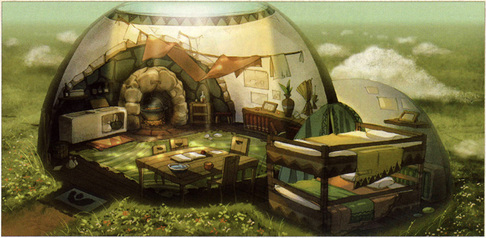
Speaking of design, it is always comforting to begin our discussion in lived space. Personal dwellings speak novels about those that live within them, and, in video games, can wordlessly build characters and personalities. Within the Knight’s Academy, celebrating its 25th year (which obviously isn’t paralleling something else), each student has a room, and each room has at least one trait that sets it apart from all others. Link’s room is surprisingly tidy, with obvious functionality; there are open books lying upon the desk, wooden shelves lined with memorabilia, and even a wood-working desk complete with carpentry tools and carved and painted statues of animals. More examples include Groose’s weight set, the bug collection of Cawlin and Strich, and the tea set and embroidery of Karane. The existence of personal hobbies says something rather telling of Skyloftian society. It is complex enough to allow for individuality, and secure enough in shelter and agriculture to allow for time spent on things that would be considered frivolous by those hard-pressed for food or resources. Hobbies reflect a certain state of advancement in a given civilization.
The layout of the city spans multiple floating islands, although most of the buildings within the town are, to a degree, centered around a central market space. The most notable places in Skyloft are the bazaar, residential quarter, bathhouse, plaza, the Light Tower, Knight Academy and Sparring House, a boarding school, the Island of the Goddess, a cave system, graveyard, and many small gardens and plots of farmland. Society is stratified, though most everyone seems content, and each person has a particular role in the functioning of daily life.
Architectural influence and design is different depending on where in Skyloft one is, and the land can be divided into two basic parts: the town and the Island of the Goddess. Their styles, periods of construction, and histories are quite distinct, and thus it is necessary to look at them separately. That said, Skyloft is also a gestalt and therefore must be considered as such — a confluence of architectural traditions and cultures that harmoniously coexist with one another.
Architectural influence and design is different depending on where in Skyloft one is, and the land can be divided into two basic parts: the town and the Island of the Goddess. Their styles, periods of construction, and histories are quite distinct, and thus it is necessary to look at them separately. That said, Skyloft is also a gestalt and therefore must be considered as such — a confluence of architectural traditions and cultures that harmoniously coexist with one another.
By far the most obvious characteristic of the town itself is the prodigious and extensive use of color. Each building has a different and delightful hue that even varies within that individual color spectrum. Other diverse-colored bricks seem placed at random within these walls, though what the walls are made of (perhaps adobe, or bricks covered with colorful mortar) remains unknown. But that is unimportant. What should be stressed is the vibrancy and life of the buildings themselves; combined with the fanciful, fluid, and playful shapes of the walls, these colors give great insight as to the general temperamental condition of the inhabitants of Skyloft. Likewise, the majority of windows within this town are of variegated stained glass, which project beams of light that are really quite lovely. The windows, paralleling the walls, are whimsical in shape, and reinforce the sense of ebullience that is present here. Mosaic designs are also prevalent, and often exist in colors that starkly contrast the main house or wall color. From a structural standpoint, there is nothing overly unique about the buildings within the town; many past and present cultures have constructed their dwellings in and under hills, or have used packed earth and grass as a roof. The bazaar is quirky, but it is really just a complex of tents and posts. Nothing is remarkable or outstanding in its own right, but the effect, the impression, is what continually stands out about Skyloft.
To me, this speaks of the entire artistic nature of this game. Impressionistic in intent and in style, the emotions we take from various locations within this realm are meant to give us vague and nondescript feelings; in this case, the actual designs of structures in Skyloft are not meant to tell a particular story as with other architectural entities, but are instead meant to impart a reactionary and emotional vision. In this instance, the feelings evoked are those of blueness, sky, air, peace, certainty, and happiness. It paints a very lovely picture, no?
Yet, even while that may be true, it does not mean that there are no details to discuss. A design with lingering religious undertones, the Loftwing is prominently displayed in nearly every feature of this city. From the save statues (which are viewed as shrines by the villagers) to the topmost portion of the fence posts, to the mosaic inlays found around Skyloft, this motif is nearly everywhere. And, given what we know of the religious practices of this people, it makes perfect sense. A few other details are also worth mentioning. Especially near to the bazaar, huge wooden posts support strings of flags (that look of a Mexican or Tibetan heritage) and pinwheels that gyre in the breeze. As these quiver and flow with the wind, the importance of air and of flight adds itself to the overall impression, enriching it immensely.
To me, this speaks of the entire artistic nature of this game. Impressionistic in intent and in style, the emotions we take from various locations within this realm are meant to give us vague and nondescript feelings; in this case, the actual designs of structures in Skyloft are not meant to tell a particular story as with other architectural entities, but are instead meant to impart a reactionary and emotional vision. In this instance, the feelings evoked are those of blueness, sky, air, peace, certainty, and happiness. It paints a very lovely picture, no?
Yet, even while that may be true, it does not mean that there are no details to discuss. A design with lingering religious undertones, the Loftwing is prominently displayed in nearly every feature of this city. From the save statues (which are viewed as shrines by the villagers) to the topmost portion of the fence posts, to the mosaic inlays found around Skyloft, this motif is nearly everywhere. And, given what we know of the religious practices of this people, it makes perfect sense. A few other details are also worth mentioning. Especially near to the bazaar, huge wooden posts support strings of flags (that look of a Mexican or Tibetan heritage) and pinwheels that gyre in the breeze. As these quiver and flow with the wind, the importance of air and of flight adds itself to the overall impression, enriching it immensely.
At the feet of the goddess, where the Loftwing theme becomes most prominent. Notice the angularity of the pedestal, and of the towers and bird statues, in contrast to the gentle curves of the statue above.
The Island of the Goddess has a very different feeling than that of the town. In the Hyrule Historia, we are told that the Statue of the Goddess has transcended religion, becoming a point of interest and attraction for the townsfolk. Its prominent place means that it can be seen from anywhere in the city. This area of town is meant to feel worn and sacred. Its change in music, and focus on showcasing the juxtaposition of the statue with the blue sky and clouds, gives this place a greater gravity than the light-hearted town below. And this is completely logical, as it was not constructed by the Skyloftians, who have never known famine, war, or violence. It is a more solemn place, and, as history tells, it was ripped from the ground and placed in the sky, originally a part of the ancient Sealed Temple. Grey stone lined with mortar and flecked with lichen, high walls, and freestanding columns guide wayfarers to the feet of the statue, humbling them simply by proximity.
Yet, that is not the most haunting aspect of this place. That is reserved for what lies directly below the statue proper. One evening, Link is awakened by a chill voice in his room, and is bidden to follow its source to the Island of the Goddess. A starlit chase ensues, with elegant yet haunting flute music that quite perfectly augments the mood, and a pregnant golden moon hangs overhead, watching the pursuit unfold. Eventually, the Hero is led beneath the Statue of the Goddess, descending down a hallway leading to the Chamber of the Sword, wherein rests the Goddess Sword. Within the Hyrule Historia, it states: “The interior, unlike the city around it, uses more straight lines and angles and, coupled with the monochrome coloring, gives the impression of permanence and inflexibility.” We can see the truth of this for ourselves. Ultimately, it is here that all of the previously-disparate aspects of design throughout Skyloft come together. Symbols well-known to us, such as the Goddess Harp, the Triforce, and the Goddess herself bearing aloft a sword, rest upon the columns, flank the doorways, and grace the faded stone of the walls. In fact, this is the first time that the full Triforce is shown, making known the relationship between Hylia and the Three Golden Goddesses who created the world and all within. The fluid and benign contours of the Statue of the Goddess stand in glaring contrast to this interior space, which is the true sanctum. Perhaps the playful lines of the statue were meant to fool those who meant evil into thinking that nothing sacred could be found beneath such an innocent carving. It is interesting that, within this context, sacredness manifests itself in angularity. It is as though the flexibility and freedom of the town is somehow at odds with this chamber, which seeks to portray itself as timeless and rigid. This city in the heavens has two very different faces, each of which brings about a very different impression in the observer. In this case, the true heart of the island is as a cut diamond buried in the soft loam of the innocuous and friendly space above. And, for that, it is all the more rare, and all the more elegant.
Yet, that is not the most haunting aspect of this place. That is reserved for what lies directly below the statue proper. One evening, Link is awakened by a chill voice in his room, and is bidden to follow its source to the Island of the Goddess. A starlit chase ensues, with elegant yet haunting flute music that quite perfectly augments the mood, and a pregnant golden moon hangs overhead, watching the pursuit unfold. Eventually, the Hero is led beneath the Statue of the Goddess, descending down a hallway leading to the Chamber of the Sword, wherein rests the Goddess Sword. Within the Hyrule Historia, it states: “The interior, unlike the city around it, uses more straight lines and angles and, coupled with the monochrome coloring, gives the impression of permanence and inflexibility.” We can see the truth of this for ourselves. Ultimately, it is here that all of the previously-disparate aspects of design throughout Skyloft come together. Symbols well-known to us, such as the Goddess Harp, the Triforce, and the Goddess herself bearing aloft a sword, rest upon the columns, flank the doorways, and grace the faded stone of the walls. In fact, this is the first time that the full Triforce is shown, making known the relationship between Hylia and the Three Golden Goddesses who created the world and all within. The fluid and benign contours of the Statue of the Goddess stand in glaring contrast to this interior space, which is the true sanctum. Perhaps the playful lines of the statue were meant to fool those who meant evil into thinking that nothing sacred could be found beneath such an innocent carving. It is interesting that, within this context, sacredness manifests itself in angularity. It is as though the flexibility and freedom of the town is somehow at odds with this chamber, which seeks to portray itself as timeless and rigid. This city in the heavens has two very different faces, each of which brings about a very different impression in the observer. In this case, the true heart of the island is as a cut diamond buried in the soft loam of the innocuous and friendly space above. And, for that, it is all the more rare, and all the more elegant.

